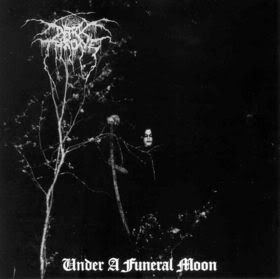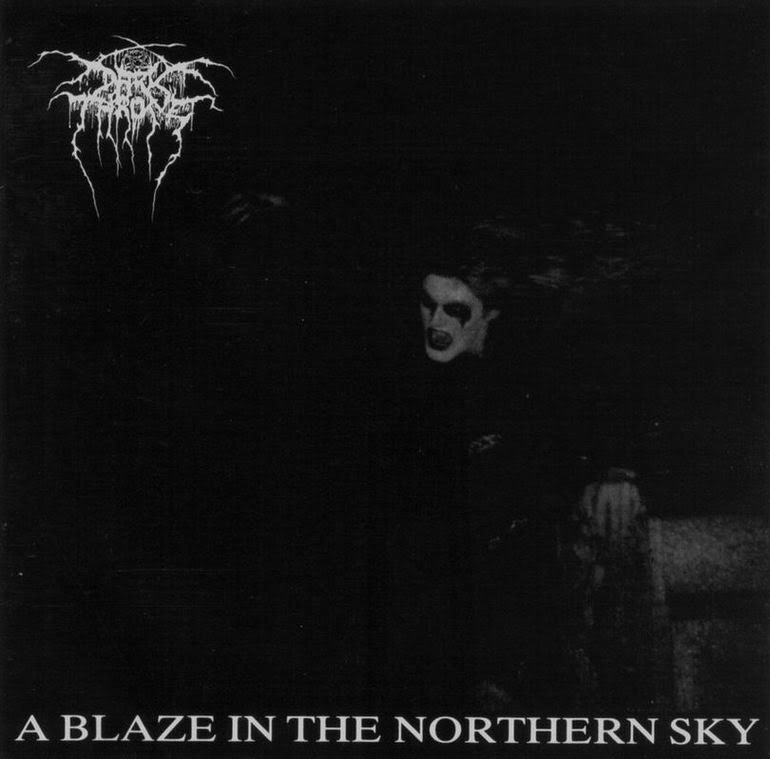Diabolical Fullmoon Mysticism is the first full-length from Norwegian Black Metal band Immortal. The album was recorded in Grieghallen Studios, around the same time as Det Som Engang Var, and produced by Pytten. The sound is very similar to that of early Burzum, due to similar production. There is a strong Bathory influence here, particularly from Blood Fire Death. This is evident from the opening moments of the album. As with so many great bands, my first exposure to Immortal came from "The Haunted Mansion". One Winter night, I heard the song "The Sun No Longer Rises", from Pure Holocaust and I wasted little time in acquiring that album. Some time later, while in Oslo, I picked up their debut L.P. and it wasn't long before I had a new favorite Immortal album. It was a close call, but songs like "Cryptic Winterstorms" left no doubt as to which album I preferred and it accompanied me on many late night drives through desolate areas. Often, I seemed to have the roads all to myself and had this album blasting as the cold winds blew in through the open window, blowing through my hair and freezing my fingers. Peaceful times... Abbath Doom Occulta, Demonaz Doom Occulta and Armagedda came together to create a very memorable album of grim Black Metal. While the following album usually tends to get the most praise, I feel that this one is an undeniable classic and should not be overlooked.
The album opens with a short intro that is very reminiscent of Bathory, especially with the sound of the winds and the acoustic guitar. Already, you can feel the icy hands of Winter taking hold.
"The Call of the Wintermoon" unleashes the fury from the north, as the fast tremolo riffs and blasting drums rage forth like an arctic storm. The riff is simple yet very effective. In no time, the tempo changes and Armagedda employs a very oldschool drumbeat, typical of 80s bands like Venom and Mercyful Fate. Abbath's screams are noticeably different than the severely grim croaking sound that he would utilize on the next album. I actually prefer this style as it seems more natural. There is a coldness created here as well as a sense of doom. The solo is very well done and I wish more Black Metal bands found ways to fit decent solos into their music. The song evokes imagery of being summoned by the full moon for battle in the cold Winter night.
"Unholy Forces of Evil" is next and begins with an oldschool style as well as Abbath's possessed vocals. Demonaz's guitar riffs have an sense of something ancient and produce images of old, forgotten tombs and battlefields littered with corpses long dead. The song features some very 80s-based riffs, throughout most of the song, but also some faster parts with the typical tremolo riffing of Norwegian Black Metal.
"Cryptic Winterstorms" begins with a cold, mournful acoustic guitar as the song begins. The song is mid-paced and carries an epic feeling. The acoustic guitar appears again, throughout the song, and the main melody is very mournful. This song is reminiscent of Bathory and Burzum, without sounding too close to either one. This is, absolutely, my favorite Immortal song ever and is included on a mix tape I made for my car, somewhere between Darkthrone's "Paragon Belial" and Burzum's "Black Spell of Destruction". The solos are perfectly done and Abbath's vocals add a lot to the atmosphere. His screams could be described as very wild and animalistic as compared to later albums.
Following this epic masterpiece is "Cold Winds of Funeral Dust". This song begins slowly and includes some thundering drums. This is pure oldschool Black Metal, and could have easily been released in 1989 or so. The pace is similar to something you would find on Blood Fire Death, yet there are enough harmonies layered on top of that that give it a distinct Norwegian sound. Abbath's vocals are evil as Hell, here. Near the end, the song speeds up to a furious pace, somewhat similar to something found on Gorgoroth's debut album, before fading out.
"Blacker Than Darkness" continues the album and starts with a mid-paced riff. In a short time, the song speeds up to a thrashy pace that would not be out of place on The Return... The riffs are very memorable, as every song in here possesses an identity of its own. There is no filler here.
The album ends with "A Perfect Vision of the Rising Northland". This epic song begins with a somber accoustic piece that leads into a very evil tremolo melody as the drums slowly build up and the song takes off at a pace quite like that of the title track from Blood Fire Death. An intense spoken word part precedes Abbath's vocals, slowly appearing like some ghoul rising from a forbidden crypt. While Pure Holocaust is like a journey through the frozen lands of the North, Diabolical Fullmoon Mysticism seems to explore only the immediate area surrounding some lost Medieval castle, inhabited by spirits of pure evil, as they roam the surrounding forests and mountains, never straying too far. There is a sense of dread and melancholy in this song as it takes the listener on a long and dark journey. Late in the song, there is a slight bit of keyboard use, accompanying a spoken word part. It is done very well and only serves to add to the atmosphere as Abbath then screams:
"This Winter is forever!"
Indeed, that would be glorious... As the song continues, evil and yet sorrowful melodies inspire visions of another world where the sun freezes to dust. The same acoustic melody that began the song then returns to end the album. In a way, the title is very appropriate, as one gets the impression that only a brief vision was allowed and yet there is so much more. If only the barrier can be crossed...
.jpg)

















